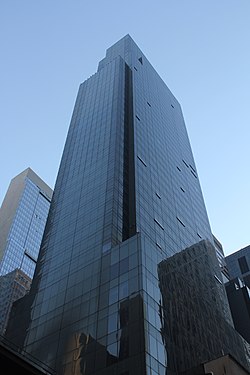
The Palace Theatre is a Broadway theater at 1564 Broadway, facing Times Square, in the Midtown Manhattan neighborhood of New York City. Designed by Milwaukee architects Kirchhoff & Rose, the theater was funded by Martin Beck and opened in 1913. From its opening to about 1929, the Palace was considered among vaudeville performers as the flagship venue of Benjamin Franklin Keith and Edward Franklin Albee II's organization. The theater had 1,743 seats across three levels as of 2018.

The New York Marriott Marquis is a Marriott hotel on Times Square, in the Theater District of Midtown Manhattan in New York City. Designed by architect John C. Portman Jr., the hotel is at 1535 Broadway, between 45th and 46th Streets. It has 1,971 rooms and 101,000 sq ft (9,400 m2) of meeting space.

The Majestic Theatre is a Broadway theater at 245 West 44th Street in the Theater District of Midtown Manhattan in New York City. Opened in 1927, the theater was designed by Herbert J. Krapp in a Spanish style and was built for real-estate developer Irwin S. Chanin. It has 1,681 seats across two levels and is operated by The Shubert Organization. Both the facade and interior are New York City landmarks.

The Hayes Theater is a Broadway theater at 240 West 44th Street in the Theater District of Midtown Manhattan in New York City. Named for actress Helen Hayes, the venue is operated by Second Stage Theater. It is the smallest Broadway theater, with 597 seats across two levels. The theater was constructed in 1912 for impresario Winthrop Ames and designed by Ingalls & Hoffman in a neo-Georgian style. The original single-level, 299-seat configuration was modified in 1920, when Herbert J. Krapp added a balcony to expand the Little Theatre. The theater has served as a legitimate playhouse, a conference hall, and a broadcasting studio throughout its history.

The Shubert Theatre is a Broadway theater at 225 West 44th Street in the Theater District of Midtown Manhattan in New York City. Opened in 1913, the theater was designed by Henry Beaumont Herts in the Italian Renaissance style and was built for the Shubert brothers. Lee and J. J. Shubert had named the theater in memory of their brother Sam S. Shubert, who died in an accident several years before the theater's opening. It has 1,502 seats across three levels and is operated by The Shubert Organization. The facade and interior are New York City landmarks.
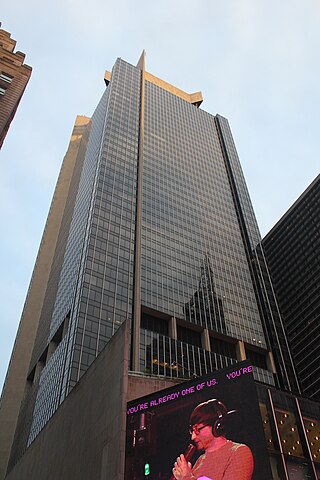
One Astor Plaza, also known as 1515 Broadway and formerly the W. T. Grant Building, is a 54-story office building on Times Square in the Theater District of Midtown Manhattan in New York City. Designed by Der Scutt of Ely J. Kahn & Jacobs, the building was developed by Sam Minskoff and Sons. One Astor Plaza occupies a site bounded by Broadway to the east, 45th Street to the north, Shubert Alley to the west, and 44th Street to the south. The building is named for the Hotel Astor, which had occupied the site from 1904 to 1967. SL Green Realty and Allianz own One Astor Plaza, which as of 2022 serves as the headquarters for Paramount Global.

The John Golden Theatre, formerly the Theatre Masque and Masque Theater, is a Broadway theater at 252 West 45th Street in the Theater District of Midtown Manhattan in New York City. Opened in 1927, the Golden Theatre was designed by Herbert J. Krapp in a Spanish style and was built for real-estate developer Irwin S. Chanin. It has 800 seats across two levels and is operated by the Shubert Organization. Both the facade and the auditorium interior are New York City landmarks.

The Belasco Theatre is a Broadway theater at 111 West 44th Street, between Seventh Avenue and Sixth Avenue, in the Theater District of Midtown Manhattan in New York City. Originally known as the Stuyvesant Theatre, it was built in 1907 and designed by architect George Keister for impresario David Belasco. The Belasco Theatre has 1,016 seats across three levels and has been operated by The Shubert Organization since 1948. Both the facade and interior of the theater are New York City landmarks.
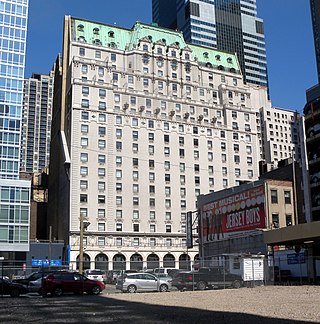
The Paramount Hotel is a hotel in the Theater District of Midtown Manhattan in New York City, United States. Designed by architect Thomas W. Lamb, the hotel is at 235 West 46th Street, between Eighth Avenue and Broadway. The Paramount Hotel is owned by RFR Realty and contains 597 rooms. The hotel building, designed in a Renaissance style, is a New York City designated landmark.

The Beacon Theatre is an entertainment venue at 2124 Broadway, adjacent to the Hotel Beacon, on the Upper West Side of Manhattan in New York City. Opened in 1929, the Beacon Theatre was developed by Samuel "Roxy" Rothafel and built as a movie palace, with 2,894 seats across three levels. It was designed by Walter W. Ahlschlager with decorations inspired by the Renaissance, Ancient Roman, Ancient Greek, and Rococo styles. The theater is designated as a New York City interior landmark and is listed on the National Register of Historic Places.
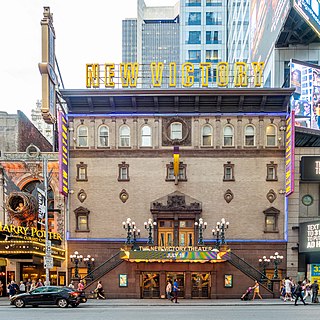
The New Victory Theater is a theater at 209 West 42nd Street in the Theater District of Midtown Manhattan in New York City, near Times Square. Built in 1900 as the Republic Theatre, it was designed by Albert Westover and developed by Oscar Hammerstein I as a Broadway theater. The theater has been known by several names over the years, including the Belasco Theatre, Minsky's Burlesque, and the Victory Theatre. The theater is owned by the city and state governments of New York and leased to nonprofit New 42, which has operated the venue as a children's theater since 1995. The New Victory presents theater shows, dance shows, puppet shows, and other types of performance art shows from all around the world.

The Hudson Theatre is a Broadway theater at 139–141 West 44th Street, between Seventh Avenue and Sixth Avenue, in the Theater District of Midtown Manhattan in New York City. One of the oldest surviving Broadway venues, the Hudson was built from 1902 to 1903. The exterior was designed by J. B. McElfatrick & Son, while Israels & Harder oversaw the completion of the interior. The theater has 970 seats across three levels. Both its exterior and interior are New York City designated landmarks, and the theater is on the National Register of Historic Places.
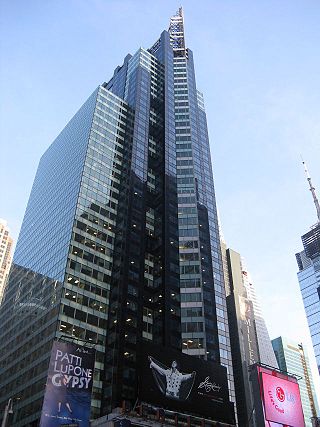
1540 Broadway, formerly the Bertelsmann Building, is a 44-story office building on Times Square in the Theater District neighborhood of Manhattan in New York City. Designed by David Childs of Skidmore, Owings & Merrill (SOM), the building was developed by Broadway State Partners, a joint venture between Bruce Eichner and VMS Development. 1540 Broadway occupies a site bounded by Broadway to the west, 45th Street to the south, and 46th Street to the north. It was originally named for its anchor tenant, German media company Bertelsmann. The building is divided into two ownership units: HSBC and Edge Funds Advisors own the office stories, while Vornado Realty Trust owns retail space at the base.

The Liberty Theatre is a former Broadway theater at 234 West 42nd Street in the Theater District of Midtown Manhattan in New York City. Opened in 1904, the theater was designed by Herts & Tallant and built for Klaw and Erlanger, the partnership of theatrical producers Marc Klaw and A. L. Erlanger. The theater has been used as an event venue since 2011 and is part of an entertainment and retail complex developed by Forest City Ratner. The theater is owned by the city and state governments of New York and leased to New 42nd Street. Brookfield Asset Management, which acquired Forest City in 2018, subleases the venue from New 42nd Street.

The Crowne Plaza Times Square Manhattan is a hotel at 1601 Broadway, between 48th and 49th Streets, in the Theater District of Midtown Manhattan in New York City. The hotel is operated by third-party franchisee Highgate and is part of the Intercontinental Hotels Group's Crowne Plaza chain. It has 795 guest rooms.

Shubert Alley is a pedestrian alley in the Theater District of Midtown Manhattan in New York City. The alley, a privately owned public space, connects 44th and 45th Streets and covers about 6,400 square feet (590 m2). It runs through the middle of a city block, parallel to Eighth Avenue to the west and Broadway to the east. The western half of the alley abuts the Shubert and Booth theaters, while the eastern half is adjacent to One Astor Plaza. Because it is near several major theaters, the alley has been considered the geographical center of Broadway theatre.

1501 Broadway, also known as the Paramount Building, is a 33-story office building on Times Square between West 43rd and 44th Streets in the Theater District neighborhood of Manhattan in New York City. Designed by Rapp and Rapp, it was erected from 1925 to 1927 as the headquarters of Paramount Pictures. The building is designed in the Art Deco and Beaux-Arts styles. The office wing on Times Square contains numerous setbacks as mandated by the 1916 Zoning Resolution, while the rear wing housed the Paramount Theatre from 1926 to 1967. Newmark & Company owns 1501 Broadway.

Row NYC Hotel is a hotel at 700 Eighth Avenue, between 44th and 45th Streets, in the Midtown Manhattan neighborhood of New York City. The hotel is 27 stories tall with 1,331 rooms. Designed by Schwartz & Gross, with Herbert J. Krapp as consulting architect, it was developed by brothers Henry and Irwin Chanin and opened on February 1, 1928, as the Hotel Lincoln. The hotel largely retains its original brick-and-terracotta facade. The interior spaces, which originally included a lobby and various restaurants on the first three stories, have been redesigned substantially over the years.

The Empire Theatre is a former Broadway theater at 234 West 42nd Street in the Theater District of Midtown Manhattan in New York City. Opened in 1912, the theater was designed by Thomas W. Lamb for the Hungarian-born impresario A. H. Woods. It was originally named for female impersonator Julian Eltinge, a performer with whom Woods was associated. In 1998, the building was relocated 168 feet (51 m) west of its original location to serve as the entrance to the AMC Empire 25, a multiplex operated by AMC Theatres, which opened in April 2000.

TSX Broadway is an under-construction 46-story mixed-use building on Times Square, at the southeastern corner of Broadway and 47th Street, in Midtown Manhattan, New York City. Developed by L&L Holding, the building will include a 669-room hotel, multi-story retail space, and an existing Broadway theater called the Palace Theatre. The TSX Broadway development involves the reconstruction of a DoubleTree hotel that was completed in 1991, as well as the lifting of the Palace Theatre at the former hotel's base. The framework of the hotel's first 16 stories remains largely intact, but the upper floors have been demolished. Work on the new structure began in 2019, and the building is planned to be completed in 2024.
